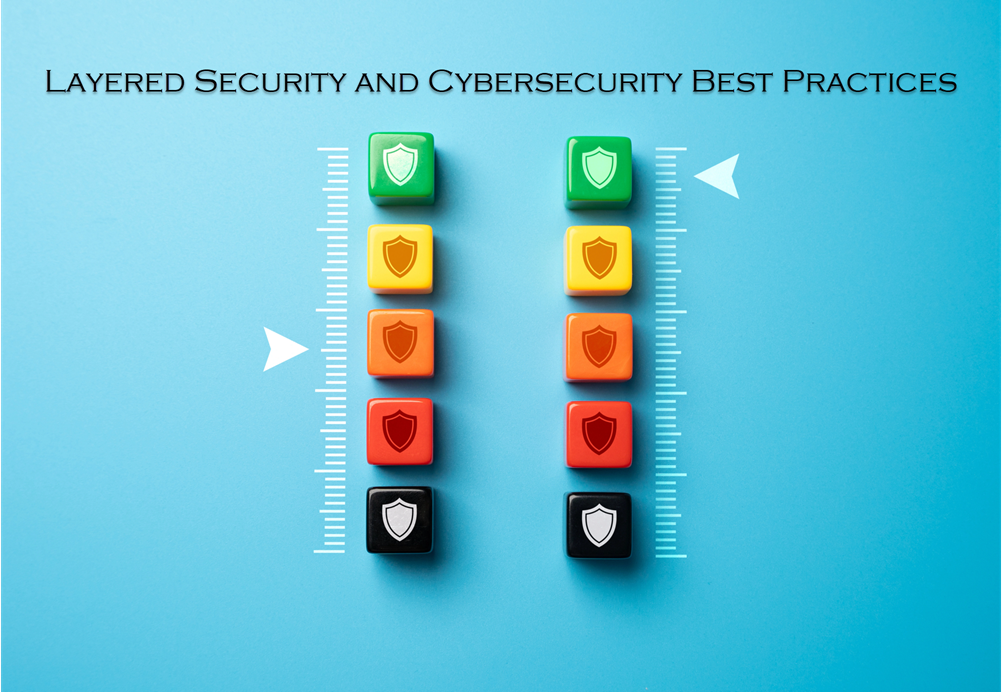Why Layered Security and Cybersecurity Best Practices Are Critical in 2024
Cybersecurity threats are becoming more sophisticated and frequent, putting businesses of all sizes at risk. In 2023 alone, the average cost of a data breach reached $4.45 million globally, up 15% from 2020, according to the IBM Cost of a Data Breach Report (IBM, 2024). This alarming increase makes it clear that organizations need to adopt robust strategies, like layered security and advanced cybersecurity best practices, to build a more resilient business. One effective approach is to implement layered security, a strategy that uses multiple defensive measures to protect an organization’s data and IT environment. Combining it with cybersecurity best practices such as Zero Trust and employee training can significantly reduce the chances of a successful attack and minimize the potential impact of security incidents.
7 Cybersecurity Best Practices to Safeguard Your Business
Adopting a multi-layered security strategy and following cybersecurity best practices can help shield your business from evolving cyber threats. Here are seven essential best practices that every organization should consider implementing in 2024.
1. Implement a Layered Security Approach
Layered security, also known as defense in depth, involves using multiple security controls to protect against cyber threats. The idea is to build multiple barriers, such as firewalls, intrusion detection systems, and endpoint protection so that even if one layer is breached, other layers remain intact to thwart the attack.
Pro Tip: Use a combination of hardware and software solutions, including network security, email filtering, and multi-factor authentication (MFA), to build a comprehensive defense.
2. Adopt a Zero Trust Security Model
The Zero Trust model operates on the principle of “never trust, always verify,” meaning that every user and device trying to access your network must be authenticated and continuously verified. This approach reduces the risk of insider threats and lateral movement within the network.
Pro Tip: Implement strict identity and access management (IAM) protocols and ensure that only verified users have access to specific parts of your network. Utilize MFA and continuous monitoring to detect anomalies.
3. Secure Cloud Configurations and Access Controls
Cloud misconfigurations are a common vulnerability that can expose sensitive data to cybercriminals. With more businesses migrating to cloud-based operations, securing cloud configurations and managing permissions is crucial.
A 2024 report by Palo Alto Networks found that 80% of cloud security incidents stem from misconfigurations (Palo Alto Networks, 2024). Regularly audit your cloud settings and implement strong access controls to prevent unauthorized access.
Pro Tip: Use Cloud Security Posture Management (CSPM) tools to identify misconfigurations and enforce least privilege access, limiting users to only the resources they need.
4. Enhance Endpoint Security
With remote and hybrid work models becoming the norm, endpoint security has become more important than ever. Every device connected to your network, whether it’s a laptop, mobile phone, or tablet, can serve as a potential entry point for cybercriminals.
Pro Tip: Deploy Endpoint Detection and Response (EDR) tools to monitor endpoint activities, detect suspicious behavior, and respond quickly to potential threats. Regularly update devices with the latest patches and security updates to address vulnerabilities.
5. Regularly Train Employees on Cybersecurity Awareness
Employees are often the weakest link in cybersecurity defenses due to human error. In fact, a 2024 report from Verizon found that 74% of all data breaches involve some form of human element, such as falling victim to phishing attacks (Verizon, 2024).
Pro Tip: Conduct regular training sessions to teach employees how to identify phishing emails, recognize suspicious behavior, and follow cybersecurity best practices. Consider running phishing simulations to test employee awareness.
6. Create and Test an Incident Response Plan
Having a well-defined incident response plan (IRP) can help your organization react quickly and effectively to cyber incidents. An IRP outlines the steps your team should take in the event of an attack, such as how to contain the threat, communicate with stakeholders, and restore systems.
Pro Tip: Update your IRP regularly and run mock scenarios to test its effectiveness. Include steps for responding to ransomware attacks, data breaches, and insider threats.
7. Stay Compliant with Industry Standards and Regulations
Compliance is more than just checking boxes, it’s a crucial aspect of your overall cybersecurity strategy. Adhering to industry standards like GDPR, CMMC, or HIPAA ensures that your business is following best practices for data protection and security.
Pro Tip: Schedule regular compliance audits and keep thorough documentation to demonstrate adherence to relevant standards. Compliance with regulations not only reduces the risk of fines but also helps protect your business from legal and reputational harm.
How 7 Layered Security and Cybersecurity Best Practices Work Together
Implementing layered security and following these best practices can significantly enhance your organization’s ability to detect, prevent, and respond to cyber threats. While layered security provides multiple barriers to stop attackers, cybersecurity best practices help fortify each layer, ensuring that your defenses are strong across the board. Together, these strategies create a holistic approach to security, making your business more resilient against both external and internal threats.
Conclusion
Cyber threats are constantly evolving, but your business can stay ahead of the curve by implementing a layered security strategy and adhering to cybersecurity best practices. From Zero Trust and cloud security to employee training and compliance, these practices will help build a more robust and resilient security posture in 2024 and beyond.
Taking a proactive approach to cybersecurity is no longer optional, it’s a necessity. Safeguard your business today by incorporating these strategies and building a strong foundation for the future.
References:
- IBM. (2024). Cost of a Data Breach Report 2024. Retrieved from IBM Cost of a Data Breach Report
- Palo Alto Networks. (2024). The State of Cloud-Native Security Report 2024. Retrieved from Palo Alto Networks Cloud Security Report
- Verizon. (2024). Data Breach Investigations Report (DBIR). Retrieved from Verizon DBIR 2024



